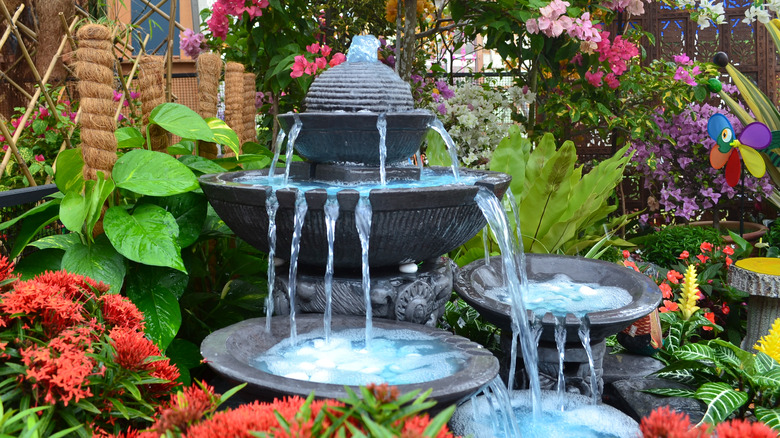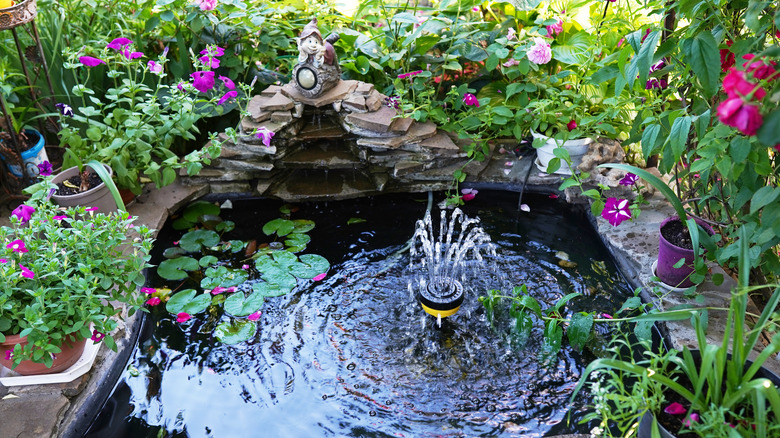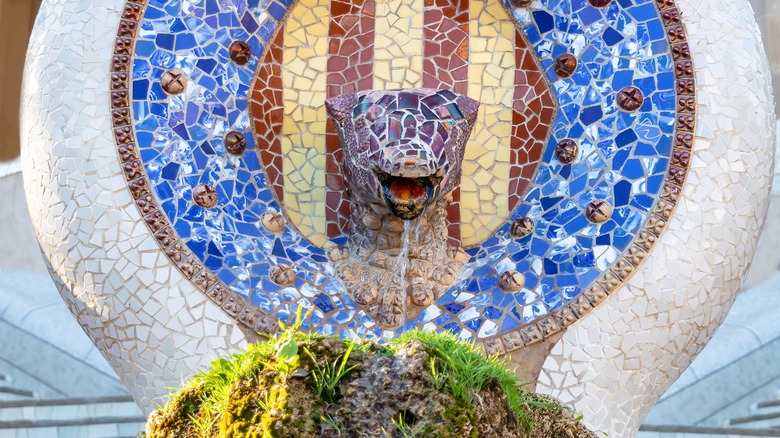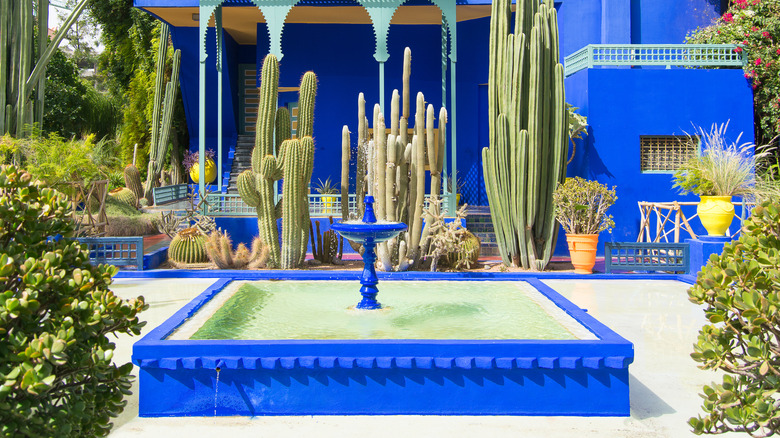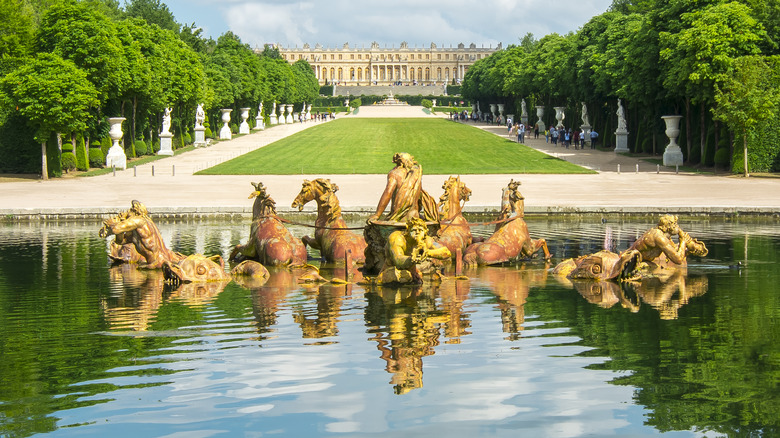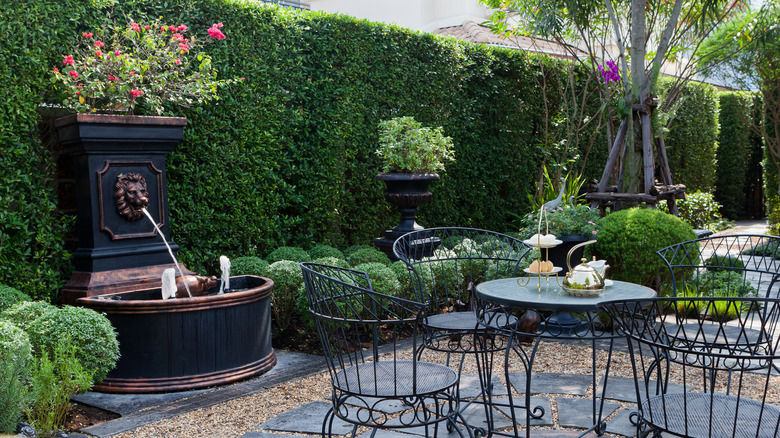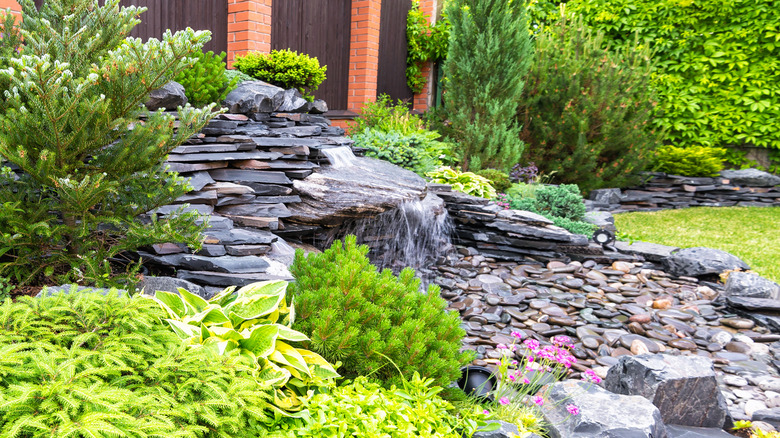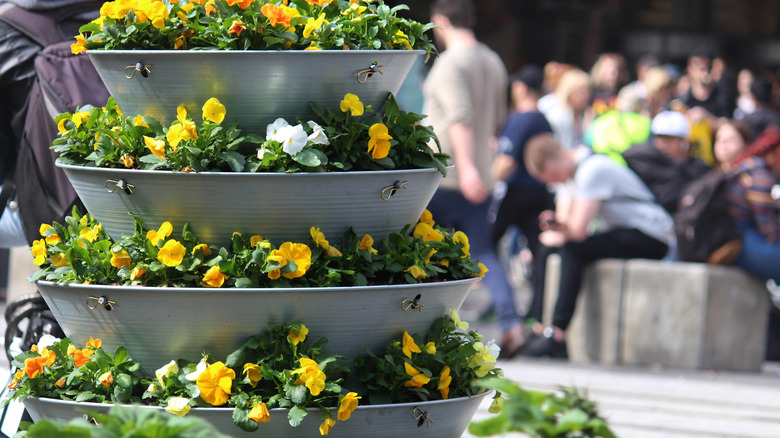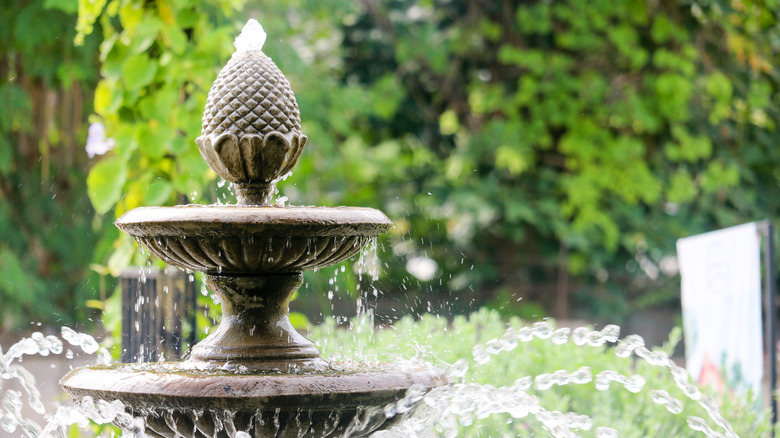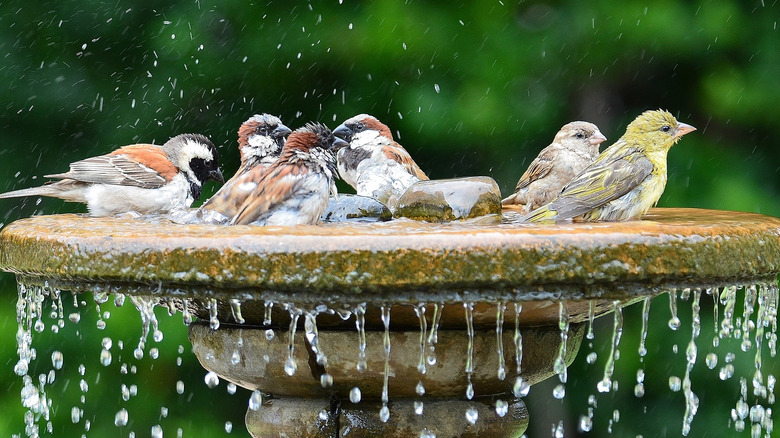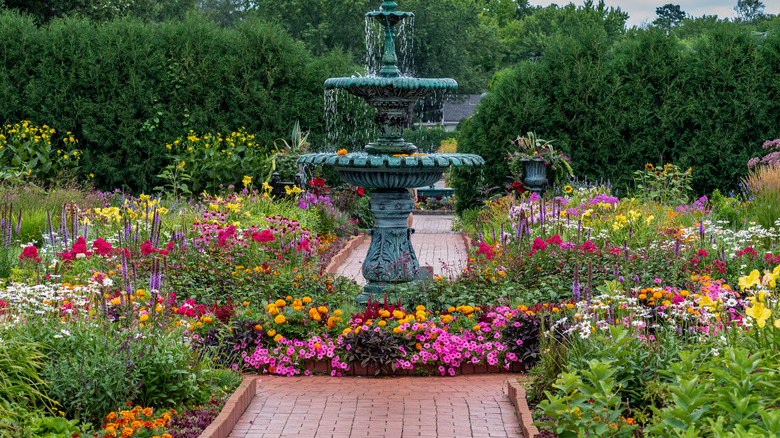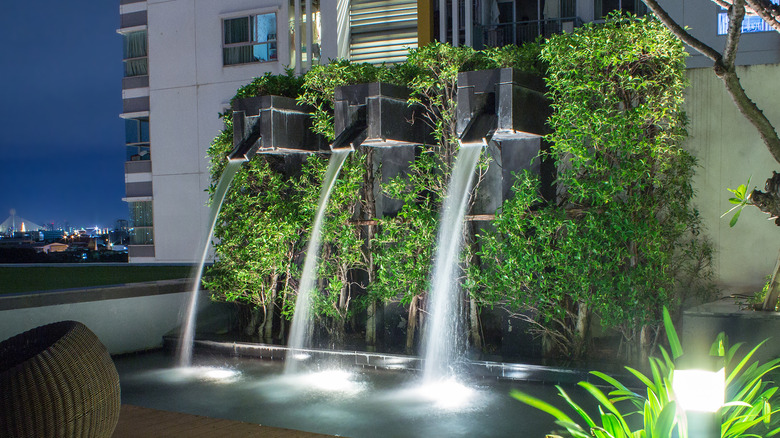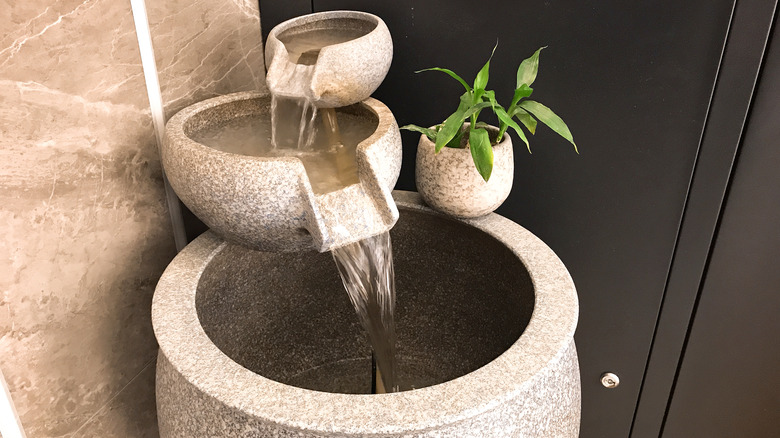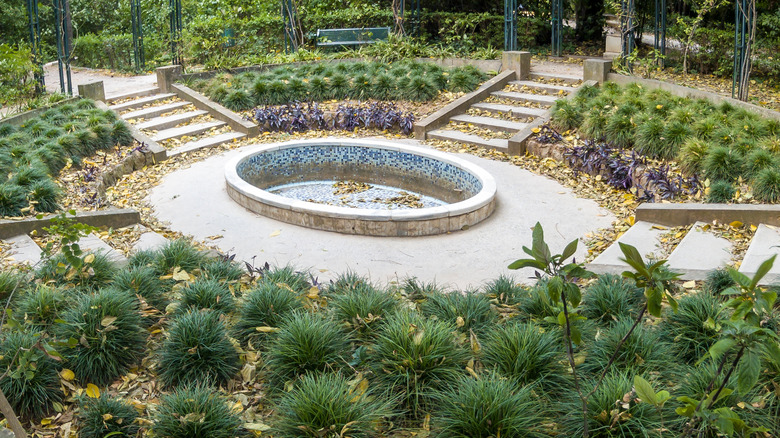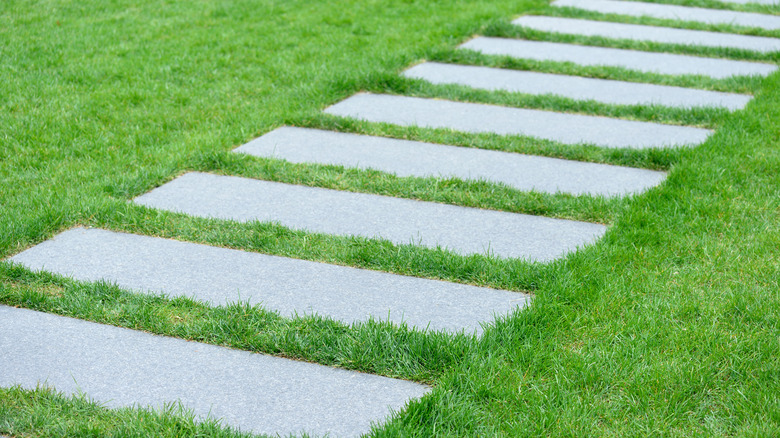How To Decorate Around A Water Fountain
The outdoor entertainment space is one area of the house that never seems to get enough decorating love. If you're thinking of redecorating your patio, your courtyard, or even your lawn, one thing not to miss is adding a water fountain. According to Sweetwater Landscape, water features add a number of enhancements to outdoor entertainment spaces. Their appearance alone creates a more relaxing ambiance thanks to the calming sounds of running water, or they can help drown out unwanted background noise in the neighborhood.
Amazing Architecture points out that while fountains require specialized maintenance, they remain popular because the enjoyment people get from them far outweighs their upkeep. Fountains come in all shapes and sizes. They can be works of art in their own right or minimalist in design. However, decorating around them can be tricky. You have to be mindful of décor that will not only work well when exposed to the elements outside, but can also survive being wet ... possibly all the time. Here is how to decorate around a water fountain.
Planting flowers adds a splash of color
Planting flowers around a fountain automatically boosts a water feature's curb appeal, as it adds a pop of much-needed color. You can choose to surround your fountain with planters, or you can add plants that thrive directly in water. According to New Pro Containers, the Japanese iris is a great pick because it not only loves to be soaked, but it can also grow up to 3 feet in height, which makes it perfect for larger water features. Elephant ears are also a good choice because they are a healthy, green plant with huge leaves that look like hearts. Their density makes for a lush garden for your fountain.
If you want to place flowers inside your fountain, Sunnydaze Décor recommends water hyacinth, which keeps its bloom for a long time; four-leaf clover, which rapidly grows to create a whimsical cover on the water; and water lettuce, which will produce bright white flowers under the best circumstances.
Use mosaics for a classic look
People have used mosaic tiles to enhance the look of water fountains for centuries. If you add the tiles to the feature in your yard, you'll give it an instant upgrade and sleek look. According to Homesteady, it's easy enough to create a DIY mosaic look, so there's no need to max out your budget on a ready-made work of art. You can purchase bits of ceramic and tile at a local home improvement store. Or, if you have things around the house you'd like to use instead, place the items in a bag, wrap the bag in a towel, and hit the contents with a stone or hammer until they are broken into a size you prefer. Just be careful not to hit things too hard, as you don't want to grind them into dust.
Tile Magazine adds that mosaics are also great to use as the fountain itself rather than just a decor element, meaning you can install a mosaic on the ground and have the fountain spurt through the floor. You'll need a bit more space and have more of an artistic eye to pull this off, but when admired from above, these fountains are breathtaking.
Paint bricks bright colors for extra fun
According to SF Gate, bricks are useful building materials for residential water fountains. But they are also popular for all sorts of other backyard water features, too. You can use them to build a fountain, add staggered waterfalls to a fountain, or bolster up nearby things like birdbaths or herb gardens with them.
According to Better Homes and Gardens, bricks normally come in earthy tones, in shades of red, orange, and brown. However, don't feel like you have to be constricted to just these choices if the colors don't work for you. Instead, consider painting the bricks for an extra pop. However, since bricks are so porous, you need to be careful about the type of paint you use not to seep in and look uneven. Be sure to speak to your local paint store for the best advice, but before you go, know that you are looking for an exterior latex primer for a first coat.
Install metal lawn art to show personality
Having a water feature on your property is already a great expression of your decorating personality, but you shouldn't leave it without a little something extra. Consider using a metal sculpture to add just a bit more personality and dimension to your outdoor spaces. According to Houzz, a great place to start is thinking about your local community and any of its symbols. If you live in Texas, you might want metal bluebonnets, so you can enjoy the state flower all year round, while Florida residents might want a more tongue-in-cheek alligator sunning himself near the fountain.
Other options could be your favorite animal or sports team memorabilia. For works that tie your fountain in with the rest of the outdoor space, consider the style of your garden. Is it modeled after the symmetrical beauty of a French garden, like the famous fountains on the grounds of Versailles? Or does it perhaps create a zen mood, like that created in a Japanese garden? To ensure your water feature's style flows seamlessly with the garden, make sure its art matches the rest of the outdoor space.
Be sure to add seating near your fountain for great ambiance
While you may want a fountain that is large enough to enjoy from many angles from your property, it's important to have seats available nearby to enjoy your fountain up close. According to The Spruce, seats of all materials and sizes can look perfect in a garden. The style you choose all comes down to your personal preferences. Wrought iron garden furniture is perfect if you are looking for an English cottage feel, but if you want to be more avant-garde, you can even create seating out of stone or wooden sculptures.
Fine Gardening adds that no matter what type of seating area you choose, the important thing is how you style it. You'll need to consider if you want to install flooring for the seating near the fountain, or if you want to place the chairs directly onto the grass. You'll want to consider how to keep the yard maintained in a high traffic area, as well as how close to the fountain you actually want to be, pending any splashes.
Add rocks and pebbles for a textured look
By using rocks and pebbles as decoration around a water fountain, you can help soften the feature's overall appearance and allow it to better blend into its overall environment. According to Zacs Garden, rock styling is most prevalent in more arid climates where grass and other greenery might not thrive. However, it's also becoming popular outside of desert areas, too. If you plan to use your fountain as a water source for any plants, then having pebbles and rocks nearby can also be great for irrigation, as they tend to keep water trapped near the roots as well as block out any harmful UV rays from the sun.
SF Gate adds that using rocks as decoration inside your fountain also adds more texture and visual interest to the water element. This is because the combination of interesting angles of the stones, the water's movement, and the gleam of the sun's light create playful patterns and delightful, relaxing sounds to enjoy.
Planting an herb garden creates great ambience
While household gardens are great to plant near a water feature in your yard, if you plan to decommission your fountain at any point, you can also turn it into a garden planter for herbs to use while cooking. According to Birds & Blooms, a popular way to utilize the unique space of a multi-tiered fountain is to have certain plants like lantana or sweet potato vine start on the top tier and then flow down the rest of the structure, much like the water used to.
MySunnyLawn adds that when you decommission your fountain, you need to ensure that its former water supply is completely turned off and disconnected. If it's not, you risk washing away your hard work if there is a big leak, or drowning your plants over time through a small one. Drainage will still be an issue, however, so you'll need to add landscaping fabric to the bottom of the fountain to discourage corrosion, as well as small rocks or pebbles to leave a bit of breathing room.
Give fountains a facelift with painted concrete
If you have an older fountain that needs new life, consider painting it to invigorate it. Painting your fountain is also a good idea if you want it to match its surroundings better. That is, perhaps your brick fountain is a light gray, but you have red brick pathways throughout your garden, and you want them to match. You can also paint your fountain to make it a more dramatic piece that you don't need to decorate around.
According to Homesteady, to properly paint a concrete fountain, you'll first need to disassemble it as much as you can. Next, give the fountain a good deep cleaning. You can do this by using gentle dish soap and warm water. You can use a toothbrush, paintbrush, or rag to scrub any mildew and dirt from its surface gently. Once everything is clean and dry, you can begin painting. To ensure the best look, get paint especially for cement.
Encourage wildlife with bird feeders
If you don't mind your water fountain doubling as a bit of a birdbath, adding bird feeders nearby will make the space inviting to wildlife. According to BBC Wildlife, birds that primarily eat seeds love taking a dip in an inviting pool of water for a bit of a splash and a bit of something to drink after a dry meal. If you live in a colder climate, keep an eye on the water to ensure it doesn't freeze over, as it will damage your fountain. However, avoid salting it to keep it from freezing because even trace amounts of salt water can harm visiting birds, even killing some of them.
You can put different kinds of seeds in other feeders to attract different types of wildlife. However, you will have to routinely change the kind of seed on offer, as endemic birds and seasonal migratory birds often enjoy different types of foods. A final safety caveat to consider is to ensure your fountain and feeders are not too close to your home. This is to minimize the risk of avian collisions with windows.
Create a designated pathway to your fountain
To get up close and personal with your water feature, you'll want to have a designated path to it. This way, you don't have to wear down your lawn or walk through your flower beds to get to it. According to The Family Handyman, a nice garden path doesn't have to be expensive, nor does it need to be in a straight line. In fact, some of the nicest garden paths are lazy, creating a winding stroll through the yard.
Popular materials for garden paths are mulch, gravel, stone, and even concrete if you want a more permanent variety. You can choose to have your path lead directly to your fountain, take a meandering route around your garden, or even enclose your water feature within a loop, so it can be admired from all sides. While your path doesn't need borders, you might choose to use brick, stone, metal, or even plastic borders to keep everything contained.
Install lights to enjoy your fountain at night
There's nothing worse than having a beautiful water feature that disappears as soon as the sun goes down. So, by properly lighting your fountain, you can enjoy it at any time of day. According to Creative Nightscapes, it's important to find the right angle when lighting a fountain to maximize enjoyment. This is because an angle that is too direct can easily create a glare on the surface of the water, making it less appealing. You'll also want to hide the actual light itself where it isn't too visible in the daytime, so it doesn't detract from the beauty of the water feature.
McKay Landscape Lighting adds that you can even place special waterproof lighting fixtures inside the fountain itself, which creates an unmatched experience each evening. However, don't try to install these types of lights yourself, as attempting to mix water with electricity can easily go wrong if you are not a trained professional.
Turn your water fountain into a statue
Fountain designs come in all shapes and sizes, lending themselves to all types of creativity. Because of this, one of the best ways to decorate around a water fountain is to turn the water fountain itself into a work of art. You can do this by using the tiers, the basin, and the area surrounding it as parts of a large sculpture. According to This Old House, just because you aren't a sculptor doesn't mean you can't use water as a work of art.
Even something as simple as a few stones stacked on top of each other can be a unique take on a fountain. You can also repurpose an old vase to be the fountain's basin, or create a doorway-shaped fountain that drizzles water like rainfall. Lean into your creativity here. And if a custom-made, sculptural fountain isn't in your budget, there are plenty of unique options that are pre-made and ready to come home with you.
Use fountains to create symmetry
Why have one water fountain in your garden when you can have two? One of the best ways to decorate around a water fountain is to complement your fountains with symmetry. You can do this by adding a second or even third feature. According to The Fountain, you can use bilateral symmetry to create halves that are mirror images with a fountain on each, or radial symmetry by placing the fountain in the center with other water features branching out from it.
Each of these designs add an air of balance and elegance to your outdoor space. However, GardenDesignExposed comments that when decorating your garden and placing symmetrical elements, the measurements do not have to be perfectly exact to complement each other. This design style, known as approximate symmetry, still accomplishes the same end result of something that is also mathematically perfect: beauty. So, if you would like to plan and execute your garden's water features on your own, you can ... even if you don't have a Ph.D. in engineering.
Consider large stone slabs instead of pavement
If you plan to create an area for gathering around your fountain, you might consider using stone slabs instead of pavement as a flooring option. According to the Landscaping Network, slabs are a nice, stable option that offers great opportunities for plant life since growth can easily thrive between the slabs. When designing and decorating a fountain, you can draw on this concept and even place small tributaries leading to the fountain between the larger slabs of stone to create an even bigger water feature.
There are two main types of slabs: natural and engineered. For natural slabs, the stone comes from a rock sanded down into the correct shape, while engineered slabs are mixed together and poured into the correct shape. Both types are equally long-lasting, similar in price points, and look great. You can simply choose whichever one you like best.
